"Sauternes...the other white wine..."
By Louis S. Luzzo, Sr.
 As many of you are well aware by now, we have an interesting dynamic here at GGM. Elaine is most definitely the driving force here when to comes to ideas and I am relied upon to get it done. Rightly so, the magazine is named for her as she is a wealth of culinary information, challenging us constantly with the depth and breadth of her 'foodie knowledge and vision.' She is my muse as well, and what you get here in the articles and features we do, is usually typed by my hand, but truly espouses the feelings and mindset of our combined psyches. Scary a thought as that may be..generally, if she can think it, I try to get it done. And since I love to hear myself talk, I get to share this culinary smorgasbord with you in my inimitable style and panache.
As many of you are well aware by now, we have an interesting dynamic here at GGM. Elaine is most definitely the driving force here when to comes to ideas and I am relied upon to get it done. Rightly so, the magazine is named for her as she is a wealth of culinary information, challenging us constantly with the depth and breadth of her 'foodie knowledge and vision.' She is my muse as well, and what you get here in the articles and features we do, is usually typed by my hand, but truly espouses the feelings and mindset of our combined psyches. Scary a thought as that may be..generally, if she can think it, I try to get it done. And since I love to hear myself talk, I get to share this culinary smorgasbord with you in my inimitable style and panache.
That said, when discussing the final Passport of 2009, she threw out a phrase that I had not heard in some time. She explained " I don't see any discusion about Sauternes." "Sauterne?" I asked, "you mean cooking wine?" she replied "No no, Sauternes, French....white...sweet?" I played along like I 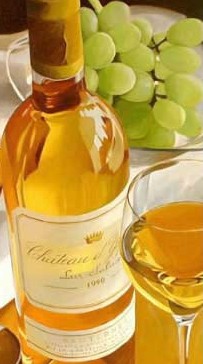 was completey on the same page. "Sure I'll look into it." Here is a perfect example of what I mean. I'd heard the name, even tasted the wine, but until she explained in her GG Style, I had no idea that with the simple addition of an 's' at the end of the word Sauterne(s), we were talking about two completely different wines. You see, Sauternes is a sweet, golden wine produced in the Bordeaux region of France, while Sauterne refers to a wide variety of white wines produced in California. If you are a wine buff, thanks for your patience....the rest of us are just catching up.
was completey on the same page. "Sure I'll look into it." Here is a perfect example of what I mean. I'd heard the name, even tasted the wine, but until she explained in her GG Style, I had no idea that with the simple addition of an 's' at the end of the word Sauterne(s), we were talking about two completely different wines. You see, Sauternes is a sweet, golden wine produced in the Bordeaux region of France, while Sauterne refers to a wide variety of white wines produced in California. If you are a wine buff, thanks for your patience....the rest of us are just catching up.
Now I can easily chalk up the reason that I have not really seen or heard any discussions about Sauterne to the fact that I'm a relative 'newbie' to serious wine culture and the exploration of wine, having only started my wine pursuit within the last 4 years. I am simply just not in the loop and surely wine bloggers and afficionados were, and are, talking about Sauternes. I looked online, in magazines, print and talked to some of my 'wine' friends and interesting fact arose; while there is some info and reference material, this is not a wine being overly covered or one that finds its name on the tips of people's tongues (no pun intended). Until now of course. So without further ado....
"Sauternes from France."
A French dessert wine from the Sauternais region of the Graves section in Bordeaux, Sauternes is made from Sémillon, Sauvignon Blanc, and Muscadelle grapes that have been affected by Botrytis 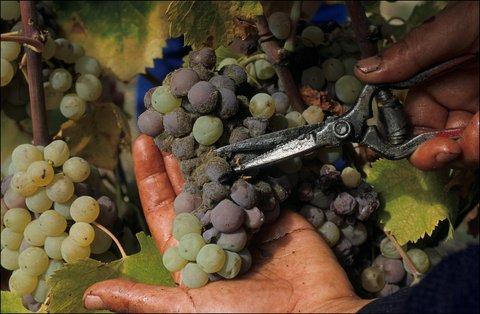 cinerea, also known as noble rot. This fungus causes the grapes to become partially raisined, resulting in concentrated and distinctively flavored wines. Sauternes is one of the few wine regions where infection with noble rot is a frequent occurrence, due to its climate. In addition, because small changes in weather conditions can have large effects on the development of this fungus, Sauternes can not be produced consistently every year and production is a hit-or-miss proposition, with widely varying harvests from vintage to vintage.
cinerea, also known as noble rot. This fungus causes the grapes to become partially raisined, resulting in concentrated and distinctively flavored wines. Sauternes is one of the few wine regions where infection with noble rot is a frequent occurrence, due to its climate. In addition, because small changes in weather conditions can have large effects on the development of this fungus, Sauternes can not be produced consistently every year and production is a hit-or-miss proposition, with widely varying harvests from vintage to vintage.
Sauternes is a perfect foil to savory and rich dishes. The classic pairing with foie gras is Sauternes; however, there are many wonderful alternatives, especially when foie gras is paired with a fruit. With today's complexities in the suaternes being produced, Sauternes balances out the acidity of the fruit with the sweetness of the wine.
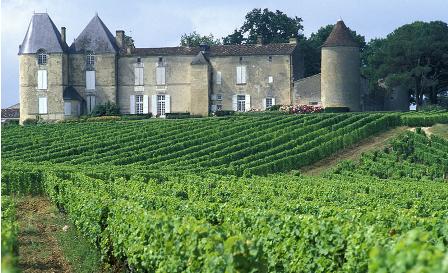 Wines from Sauternes, especially the Premier Cru Supérieur estate Château d'Yquem, (pictured left)can be very expensive, due largely to the very high cost of production and sometime rarity of vintage, as this famed chateau will not make a wine in a less-than-perfect year. The most expensive bottle I could find is available in Switzerland at Bellinzona Wine Merchants. They have a bottle of "1811 d'Yquem" for $77,797.50, but if that is a bit out of your league, you and I may enjoy the 2008 version for about $55.00. Ok, so that we know or remember what it is, let's take a closer look...
Wines from Sauternes, especially the Premier Cru Supérieur estate Château d'Yquem, (pictured left)can be very expensive, due largely to the very high cost of production and sometime rarity of vintage, as this famed chateau will not make a wine in a less-than-perfect year. The most expensive bottle I could find is available in Switzerland at Bellinzona Wine Merchants. They have a bottle of "1811 d'Yquem" for $77,797.50, but if that is a bit out of your league, you and I may enjoy the 2008 version for about $55.00. Ok, so that we know or remember what it is, let's take a closer look...
In the Beginning....
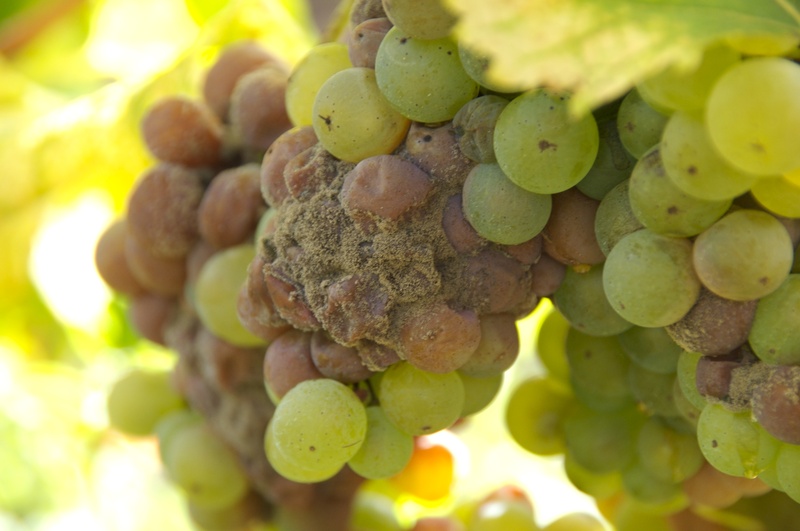 In the 17th century, Dutch traders active in the trade of German wines started looking for other sources of white grapes when production in Germany began to wane as the popularity of beer increased. The Dutch saw an opportunity for a new production source in Bordeaux and began investing in the planting of white grape varieties. They introduced to the region, German white wine making techniques, such as halting fermentation with the use of sulphur in order to maintain residual sugar levels. Sulphur stuns the yeasts, eventually bringing fermentation to a halt with high levels of sugars still in the wine. The Dutch began to identify areas that could produce grapes well suited for white wine production and soon honed in on the area of Sauternes. The wine produced from this area was known as vins liquoreux but it is not clear if the Dutch were actively using nobly rotted grapes at this point.
In the 17th century, Dutch traders active in the trade of German wines started looking for other sources of white grapes when production in Germany began to wane as the popularity of beer increased. The Dutch saw an opportunity for a new production source in Bordeaux and began investing in the planting of white grape varieties. They introduced to the region, German white wine making techniques, such as halting fermentation with the use of sulphur in order to maintain residual sugar levels. Sulphur stuns the yeasts, eventually bringing fermentation to a halt with high levels of sugars still in the wine. The Dutch began to identify areas that could produce grapes well suited for white wine production and soon honed in on the area of Sauternes. The wine produced from this area was known as vins liquoreux but it is not clear if the Dutch were actively using nobly rotted grapes at this point.
Wine expert Hugh Johnson has suggested that the unappealing thought of drinking wine made from fungus-infested grapes may have caused Sauternes producers to keep the use of Botrytis a secret. There are records from the 17th century that by October, Sémillon grapes were known to be infected by rot and vineyard workers had to separate rotted and clean berries but they are incomplete in regards to whether the rotted grapes were used in the wine making. By the 18th century, the practice of using nobly rotted grapes in Tokaji and Germany was well known. It seems that at this point the "unspoken secret" was more widely accepted and the reputation of Sauternes rose to rival those the German and Hungarian dessert wines. By the end of 18th century, the region's reputation was internationally known: Thomas Jefferson was an avid connoisseur. Jefferson recorded that after tasting a sample of Château d'Yquem while President, George Washington then immediately placed an order for 30 dozen bottles.
The Region
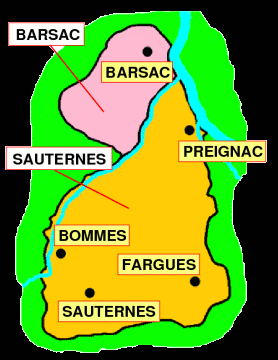 There are five villages in the Graves region of Bordeaux that make this wine style - Sauternes, Barsac, Preignac, Fargues, and Bommes. While all five communes are permitted to use the name Sauternes, the Barsac region is also permitted to label their wines under the Barsac appellation. The Barsac region is located on the west bank of the Ciron river where the tributary meets the Garonne. The area sits on an alluvial plain with sandy and limey soils. In general, Barsac wine is distinguished from other Sauternes in being drier with a lighter body; currently more Barsac producers are choosing to promote the wines under their own name. In years when the noble rot does not develop, Sauternes producers will often make dry white wines under the generic Bordeaux AOC.
There are five villages in the Graves region of Bordeaux that make this wine style - Sauternes, Barsac, Preignac, Fargues, and Bommes. While all five communes are permitted to use the name Sauternes, the Barsac region is also permitted to label their wines under the Barsac appellation. The Barsac region is located on the west bank of the Ciron river where the tributary meets the Garonne. The area sits on an alluvial plain with sandy and limey soils. In general, Barsac wine is distinguished from other Sauternes in being drier with a lighter body; currently more Barsac producers are choosing to promote the wines under their own name. In years when the noble rot does not develop, Sauternes producers will often make dry white wines under the generic Bordeaux AOC.
With a population of 1,010,000, The Bordeaux region is the seventh largest metropolitan area in France, and has been producing wine since the eighth century and the city is among the world's major wine industry centers. The historic part of the  city is on the UNESCO World Heritage List as "an outstanding urban and architectural ensemble" of the 18th century. Its climate is usually classified as an oceanic climate (Köppen climate classification Cfb); however, the summers tend to be warmer and the winters milder than most areas of similar classification. Substantial summer rainfall prevents it from being classified as a Mediterranean climate. How the regions climate affects the production of Sauternes and its intense sweetness is, in the autumn, the Ciron river produces mist that descends upon the area and persists until after dawn. These conditions are conducive to the growth of the fungus (noble rot) which dessiccates the grape and concentrates the sugars inside.
city is on the UNESCO World Heritage List as "an outstanding urban and architectural ensemble" of the 18th century. Its climate is usually classified as an oceanic climate (Köppen climate classification Cfb); however, the summers tend to be warmer and the winters milder than most areas of similar classification. Substantial summer rainfall prevents it from being classified as a Mediterranean climate. How the regions climate affects the production of Sauternes and its intense sweetness is, in the autumn, the Ciron river produces mist that descends upon the area and persists until after dawn. These conditions are conducive to the growth of the fungus (noble rot) which dessiccates the grape and concentrates the sugars inside.
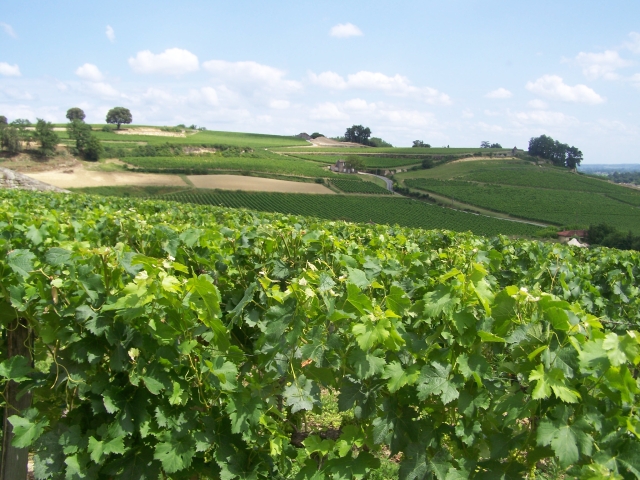 It may well be that since the area boasts some of the most well known and expensive wines in the world, Sauternes is the proverbial red-headed stepchild. Included among the list of legends are the area's five 'premier cru' (first growth) red wines (four from Médoc and one, Château Haut-Brion, from Graves), established by the Bordeaux Wine Official Classification of 1855: The first growths are: Château Lafite-Rothschild, Château Margaux, Château Latour, Château Haut-Brion, Château Mouton-Rothschild*
It may well be that since the area boasts some of the most well known and expensive wines in the world, Sauternes is the proverbial red-headed stepchild. Included among the list of legends are the area's five 'premier cru' (first growth) red wines (four from Médoc and one, Château Haut-Brion, from Graves), established by the Bordeaux Wine Official Classification of 1855: The first growths are: Château Lafite-Rothschild, Château Margaux, Château Latour, Château Haut-Brion, Château Mouton-Rothschild*
* from 1973 to present
Production
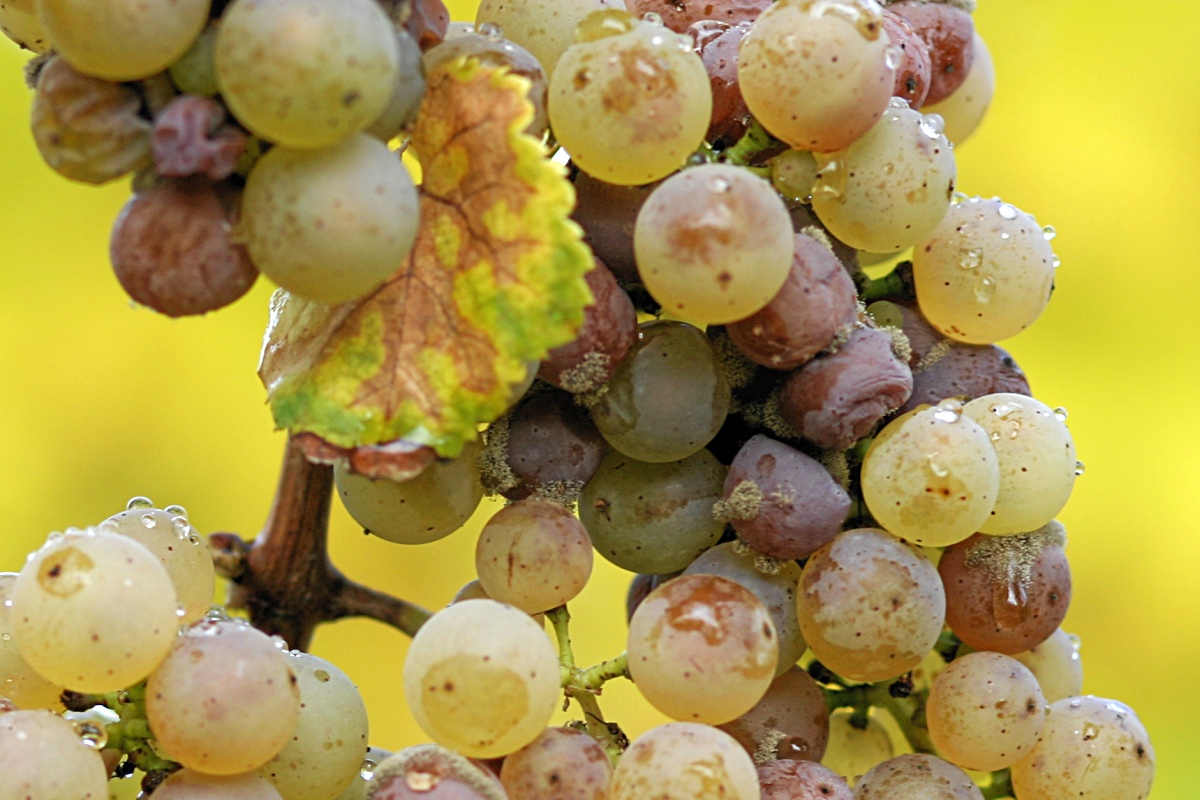 Semillon is the primary grape here as it takes well to bortrytis. Sauvignon Blanc is also used in the blend to add acidity to the richer, thicker Semillon. The process for making the sweet wines of Sauternes and Barsac is long, labored and costly. The Semillon grape is left on the vine, after it has reached maximum ripeness, until it is infected with botrytis, or noble rot. The helpful mold then shrivels the grapes, concentrating the sugar but maintaining the acids. Weather is not always agreeable and berries must be picked at just the right moment, all
Semillon is the primary grape here as it takes well to bortrytis. Sauvignon Blanc is also used in the blend to add acidity to the richer, thicker Semillon. The process for making the sweet wines of Sauternes and Barsac is long, labored and costly. The Semillon grape is left on the vine, after it has reached maximum ripeness, until it is infected with botrytis, or noble rot. The helpful mold then shrivels the grapes, concentrating the sugar but maintaining the acids. Weather is not always agreeable and berries must be picked at just the right moment, all 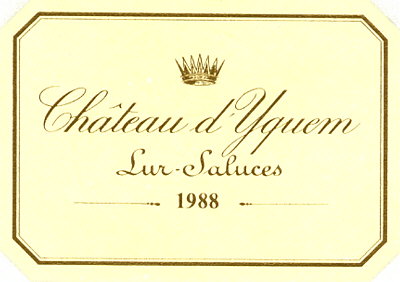 by hand. Like ice wines, the grapes do not produce as much wine as normally harvested grapes due to their shriveled and concentrated state, thereby contributing to the high cost.
by hand. Like ice wines, the grapes do not produce as much wine as normally harvested grapes due to their shriveled and concentrated state, thereby contributing to the high cost.
To qualify for the Sauternes label, the wines must have a minimum 13% alcohol level and pass a tasting exam where the wines need to taste noticeably sweet. There is no regulation on the exact amount of residual sugar that the wine needs to have.
The botrytis spores are encouraged by the mist and the warmth around the vines. Once they attach themselves to the grape they begin a process of desiccation and they chemically alter components of the grape must. This process increases the concentration of sugars and tartaric acid. During fermentation, this stimulates the production of glycerol which imparts to the resulting wine high levels of viscosity. The fungus also has a dramatic affect on aroma and flavor compounds. This unique element of botrytized wines distinguishes them from other wines that derive their sweetness from fortification, drying or being harvested late. Historically the region would average three vintages a decade producing the conditions needed for the Botrytis cinerea to fully develop. The late 20th century has been more fruitful with an average of six vintages with the needed conditions. The production of Sauternes is very labor-intensive: harvest workers hand-pick individual berries that have been properly infected with the fungus. This may require several trips throughout the vineyard over a couple of weeks. The shriveled and nearly raisin grapes yield only a small amount of juice. It is not uncommon for an entire grapevine to produce only enough juice to make a single glass of wine. This contributes to a very small production, with most producers averaging 1,000-7,000 cases a year, and is the primary reason for the high costs associated with Sauternes.
The influence with the most impact on the resulting wine takes place in the vineyard, where the character and complexity of the botrytis-infected grape is set prior to wine making. At the winery, the grapes are treated as gently as possible during pressing. In the 1980s, the controversial and expensive pre-pressing process of cryoextraction was developed. During this process, the grapes are placed in a special cooling compartment where they are chilled for 20 hours. Grapes that are less ripe have a higher water concentration than riper, sugar-saturated grapes. During this cooling process, the water is frozen, allowing the pressing process to maximize the amount of concentrated juice that is produced. Traditionalists have contended that cryoextraction is an excuse for "lazy harvesting" and that it adds to the expense of Sauternes without necessarily adding to the quality. However its use has been steadily rising, especially in poor vintage years. Fermentation frequently takes place in oak barrels with the house style dictating the amount of new oak used each vintage. Some winemakers may choose to stop fermentation prematurely by the use of sulfur dioxide, in order to maintain higher levels of residual sugar. After fermentation the wine will be aged from 18-36 months in oak prior to release.
2005 Château Guiraud Permier Cru Classé
 The annual production for the first growth is about 100,000 bottles. Some really bad years (1991 and 1993), no classified growth has been produced.
The annual production for the first growth is about 100,000 bottles. Some really bad years (1991 and 1993), no classified growth has been produced.
The first growth is produced from 209 acres of Sauternes appellation vines.Only Semillon (65%) and Sauvignon (35%) are planted at Guiraud with a pruning "à cots" or "in fan" for the Semillons and long branches for the Sauvignons.
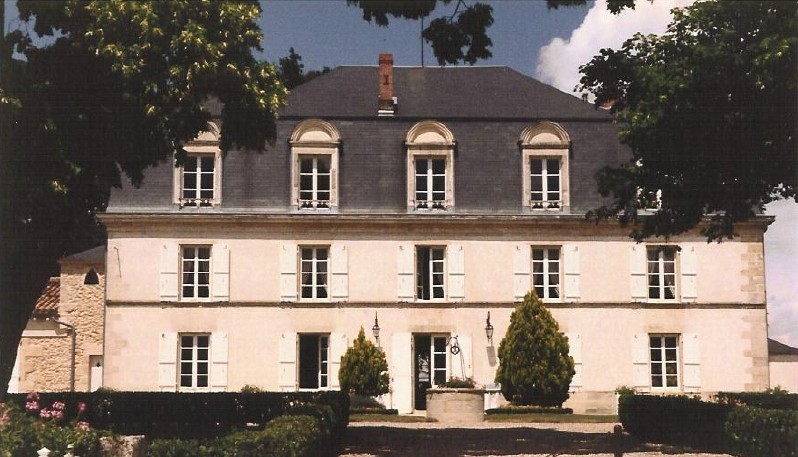 The average age of the vines is 35-40 years. Harvest is only done by hand picking in successive waves through the vineyard (2 to 7 selections), picking only the botrytised berries. A minimum of potential alcohol (20°) must be reached before starting the harvest.
The average age of the vines is 35-40 years. Harvest is only done by hand picking in successive waves through the vineyard (2 to 7 selections), picking only the botrytised berries. A minimum of potential alcohol (20°) must be reached before starting the harvest.
The fermentation made in new oak barrels over a period of three weeks to two months. Different batches are fermentated until they reach their own equilibrium which depends upon their selection.Chaptalisation, cryoextraction and any other technique used to enrich the wine are absolutely prohibited. The ageing in barrels lasts 24 months.
Winemakers notes: The wine is great, complex, and exuberant. We feel very fine aromas of crystallized orange, exotic, mentholated, and few notes of ginger. The noble rot was very beautiful this vintage, the botrytis has a splendid purity. The finale taste is explosive, honeyed, with spices and so on. Retail: $69.00


